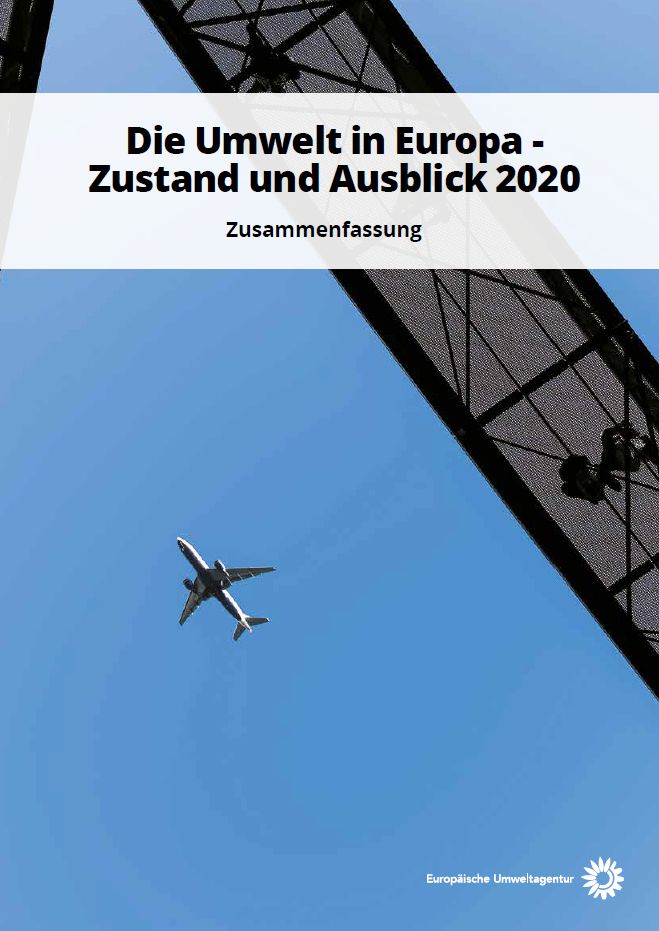Change of course urgently needed to tackle climate change, halt environmental degradation and secure future prosperity
Europe's environment is at a crossroads. We have a narrow window of opportunity over the next ten years to expand measures to protect nature, reduce the effects of climate change and drastically cut our consumption of natural resources
Hans Bruyninckx, Executive Director of the EEA
 While European environmental and climate policies have helped to improve the state of the environment in recent decades, progress has been insufficient and the outlook for the environment over the next decade is bleak, according to the report "The Environment in Europe - State and Outlook 2020en (SOER 2020)" is not positive.
While European environmental and climate policies have helped to improve the state of the environment in recent decades, progress has been insufficient and the outlook for the environment over the next decade is bleak, according to the report "The Environment in Europe - State and Outlook 2020en (SOER 2020)" is not positive.
The SOER 2020 is the most comprehensive environmental assessment ever undertaken for Europe. It provides an unsparing snapshot of Europe's position with regard to achieving the 2020 and 2030 policy targets, as well as the longer-term 2050 targets and ambitions for a shift towards a sustainable, low-carbon future. The report points out that Europe has already made significant progress in mitigating climate change by reducing greenhouse gas emissions over the past two decades. There are also signs of progress in other areas. Examples include tackling air and water pollution, new strategies to tackle plastic waste, progress on adaptation to climate change and in the areas of circular economy and bioeconomy. In addition, the EU Sustainable Finance Initiative addresses for the first time the role of the financial sector in the necessary transformation towards a sustainable future.
Urgent call to extend and accelerate change
Although these achievements are significant, Europe will not achieve its sustainability vision of "living well within the carrying capacity of our planet" if it continues to focus mainly on promoting economic growth and curbing the damaging environmental and social side-effects associated with it. The report calls on European countries, leaders and decision-makers to use the next ten years for radical structural change. Only in this way can Europe achieve its medium and longer-term environmental objectives and thus avoid irreversible environmental damage.
The current range of European policies provides an essential basis for future progress, but it is not enough. Europe needs to tackle the current environmental and climate problems better and in a completely different way, as well as rethink its investments.
Achieving the European objectives will require better implementation and coordination of current policies. Moreover, additional measures will be needed to achieve fundamental changes in the main production and consumption systems which have a significant impact on the environment and which form the basis of our modern way of life, such as food, energy and mobility.
The report also stresses the importance of governments actively shaping the transformation towards sustainability. For example, Europe should rethink how existing innovations and technologies are used and production processes optimized, how research and development towards greater sustainability could be promoted, and how changes in consumer behavior and lifestyles could be stimulated.
Such changes require investing in a sustainable future and ending the subsidisation of environmentally damaging activities with public funds. Europe would benefit enormously from such a change in investment priorities, as it can create new economic and social opportunities. At the same time, it will be crucial to listen to public concerns and secure broad support for such a change - a socially just transformation.
The State of the Environment report comes at just the right time and gives us the extra impetus we need as we start a new five-year cycle in the European Commission and prepare to unveil the European Green Deal. Over the next five years we will set a truly transformative agenda by introducing new clean technologies, helping citizens adapt to new job opportunities and changing industries, and moving towards cleaner and more efficient mobility systems and more sustainable food and farming. If we get this right, Europe and Europeans will benefit in many ways, and our economy and planet will also gain. This is an urgent global challenge and a unique opportunity for Europe
Frans Timmermans, Vice-President of the European Commission
"Europe's environment is at a crossroads. We have a narrow window of opportunity over the next ten years to expand measures to protect nature, reduce climate change impacts and drastically cut our consumption of natural resources. Our assessment shows that incremental changes have led to progress in some areas, but not nearly enough to meet our long-term goals. We already have the knowledge, technologies and tools we need to make key production and consumption systems such as food, mobility and energy sustainable. Our future well-being and prosperity depend crucially on putting this knowledge into practice. Moreover, the whole of society needs to be engaged in bringing about such changes and shaping a better future," says Hans Bruyninckx, EEA Executive Director.
The state of the environment has deteriorated, the outlook is mixed
Overall, environmental trends in Europe have not improved since the EEA's last environmental report in 2015. The assessment points out that most of the 2020 targets will not be met, especially in the area of biodiversity, but there is still the possibility of achieving the longer-term targets and objectives for 2030 and 2050.
Europe has made significant achievements in resource efficiency and the circular economy. However, recent developments point to a slowdown in progress in areas such as reducing greenhouse gas emissions, industrial emissions and waste generation, and increasing energy efficiency and the share of renewable energy. Looking ahead, the current pace of progress will not be sufficient to meet the 2030 and 2050 climate and energy targets.
Progress in the protection and conservation of biodiversity and nature in Europe is not encouraging. Of the 13 specific policy targets for 2020 in this area, only two are likely to be achieved: the designation of marine and terrestrial protected areas. If current trends continue, this will lead to further damage to nature and further pollution of air, water and soil by 2030.
The impact of climate change, air pollution and noise on the environment and human health also remains a concern. Exposure to particulate matter is responsible for around 400 000 premature deaths in Europe each year, with Central and Eastern European countries disproportionately affected. There is also growing concern about hazardous chemicals and the risks associated with them. The prospects for future reductions in environmental health risks could be improved by better integration of environment and health policies.
A sustainable future is still possible: where does action need to be taken?
Europe can still achieve its vision of a low-carbon and sustainable future. The report identifies seven key areas where bold action is needed to put Europe back on track to meet its 2030 and 2050 targets and ambitions.
- Unlock the untapped potential of existing environmental legislation: Full implementation of existing environmental legislation would make a significant contribution to Europe's progress towards its 2030 targets.
- Use sustainability as a framework for policy making: Additional long-term, overarching strategies with binding targets, for example in the areas of nutrition, chemicals and land use, have a central role to play. Such strategies enable coherent action across different policy areas and can also serve as a guide for societal change.
- Leading role in international action for sustainability: The EU should use its influence at diplomatic and economic level to promote ambitious international agreements in areas such as biodiversity and resource use.
- Promoting innovation in society: Changing the current course will depend heavily on the emergence and spread of various types of innovations that encourage new ways of thinking and living.
- Increase investment and refocus the financial sector on supporting sustainable projects and businesses: This requires investing in the future through the extensive use of public funds to support innovation and nature-based solutions, sustainable procurement and support for the industries and regions concerned. This also includes the involvement of the financial sector in sustainable investment through the implementation of the EU Sustainable Finance Action Plan.
- Managing the risks and ensuring socially balanced change: A successful sustainability transformation also requires society to deal appropriately with potential risks, opportunities and conflicting goals. EU and Member State policies play an essential role in implementing a socially acceptable transformation.
- Build more knowledge and expertise: This includes, in particular, a better understanding of the systems affecting the environment, the solutions leading to sustainability, the promising initiatives and the obstacles to change. This requires investment in education and skills to navigate a rapidly changing world.
Background - Note for the editors
The State of the European Environment and Outlook 2020 report is published by the EEA every five years in accordance with its founding Regulation. SOER 2020 is the sixth such report published by the EEA since 1995. It provides sound and science-based evidence on how we need to respond to huge and complex challenges, such as climate change, biodiversity loss and air and water pollution. SOER 2020 has been prepared in close cooperation with the EEA's European Environment Information and Observation Network (EIONET). The report draws on the vast expertise of leading experts and scientists in the environmental field in the EEA's 33 member countries and six cooperating countries.
Downloads of the study:
SOER 2020 Full Report - Integrated Assessmenten
SOER 2020 summary (translations available)
Source: EEA PM of 4.12.2019
Keywords:
Renewable, Climate protection, Media, Sustainable management, New books and studies, News Blog Europe (without DE), SDG 2030, Social / Culture, Transition Town, Environmental policy, Ecology, Economics
 The BUND Yearbook Ecological Building & Renovation, published by BUND Deutschland (BUND), helps by making owners fit for discussions with the house bank, architect, energy consultant and craftsmen. The guidebook, which will be available from November, shows what can be done and how: Based on numerous house portraits, the annual compendium helps the reader to find out which measures, building materials and technologies are best suited to their own project.
The BUND Yearbook Ecological Building & Renovation, published by BUND Deutschland (BUND), helps by making owners fit for discussions with the house bank, architect, energy consultant and craftsmen. The guidebook, which will be available from November, shows what can be done and how: Based on numerous house portraits, the annual compendium helps the reader to find out which measures, building materials and technologies are best suited to their own project.




